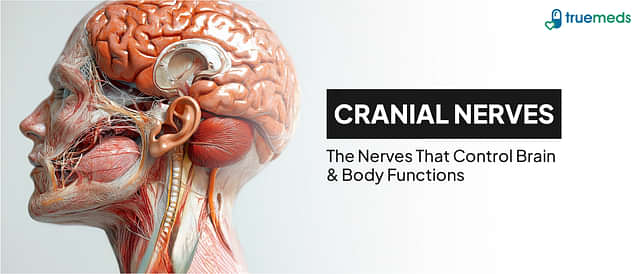Brain Aneurysm
A brain aneurysm, also known as a cerebral aneurysm, is a bulge or ballooning in a blood vessel in the brain. It occurs when there is a weakness in the wall of a blood vessel, which can cause it to stretch and balloon out. If the aneurysm ruptures, it can lead to a life-threatening condition called a subarachnoid haemorrhage.
Last updated on : 02 Sep, 2025
Read time : 14 mins
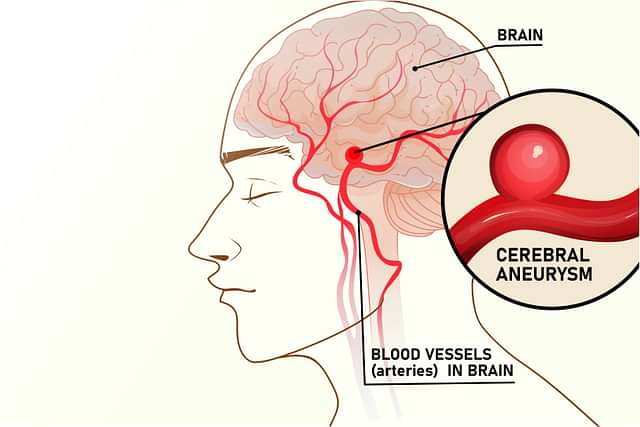
Overview of Disease
A brain aneurysm, also known as a cerebral or intracranial aneurysm, is a serious medical condition affecting the blood vessels in the brain. It is characterised by a weakened area in the wall of an artery, which causes the vessel to bulge out. This bulging can lead to a rupture, resulting in bleeding into the brain, known as a haemorrhagic stroke. Understanding the causes, symptoms, and treatment options for brain aneurysms is crucial for early detection and management of this potentially life-threatening condition.
What is a Brain Aneurysm?
A brain aneurysm is a localised weakness in the cerebral artery wall that causes the vessel to bulge out, filling with blood. The constant blood flow pressure can cause the weakened section to stretch further, increasing the risk of rupture. If the aneurysm ruptures, it can cause severe symptoms. This includes sudden and intense headaches, stiff neck, nausea, vomiting, and changes in mental status. The severity of the symptoms depends on the location and size of the aneurysm, as well as whether it has ruptured or not.
Key Factors about Brain Aneurysm
| Category | Details |
| Also Referred as | Cerebral aneurysm, intracranial aneurysm |
| Commonly Occurs In | Major arteries along the base of the brain, particularly in the circle of Willis |
| Affected Organ | Brain |
| Type | Saccular (berry aneurysm), Fusiform, Mycotic |
| Common Signs | Severe headache, Nausea, Stiff neck, Blurred vision, Dilated pupils, Sensitivity to light, Drooping eyelid, Confusion, drowsiness, Muscle weakness, Numbness, Problems speaking, Seizures, Sentinel or warning headaches |
| Consulting Specialist | Neurologist, Neurosurgeon |
| Treatement Procedures | Surgery (clipping or coiling), Endovascular coiling, Flow diversion |
| Mimiciking Condition | Stroke (haemorrhagic, ischaemic), Other neurological disorders |
Types of Brain Aneurysm
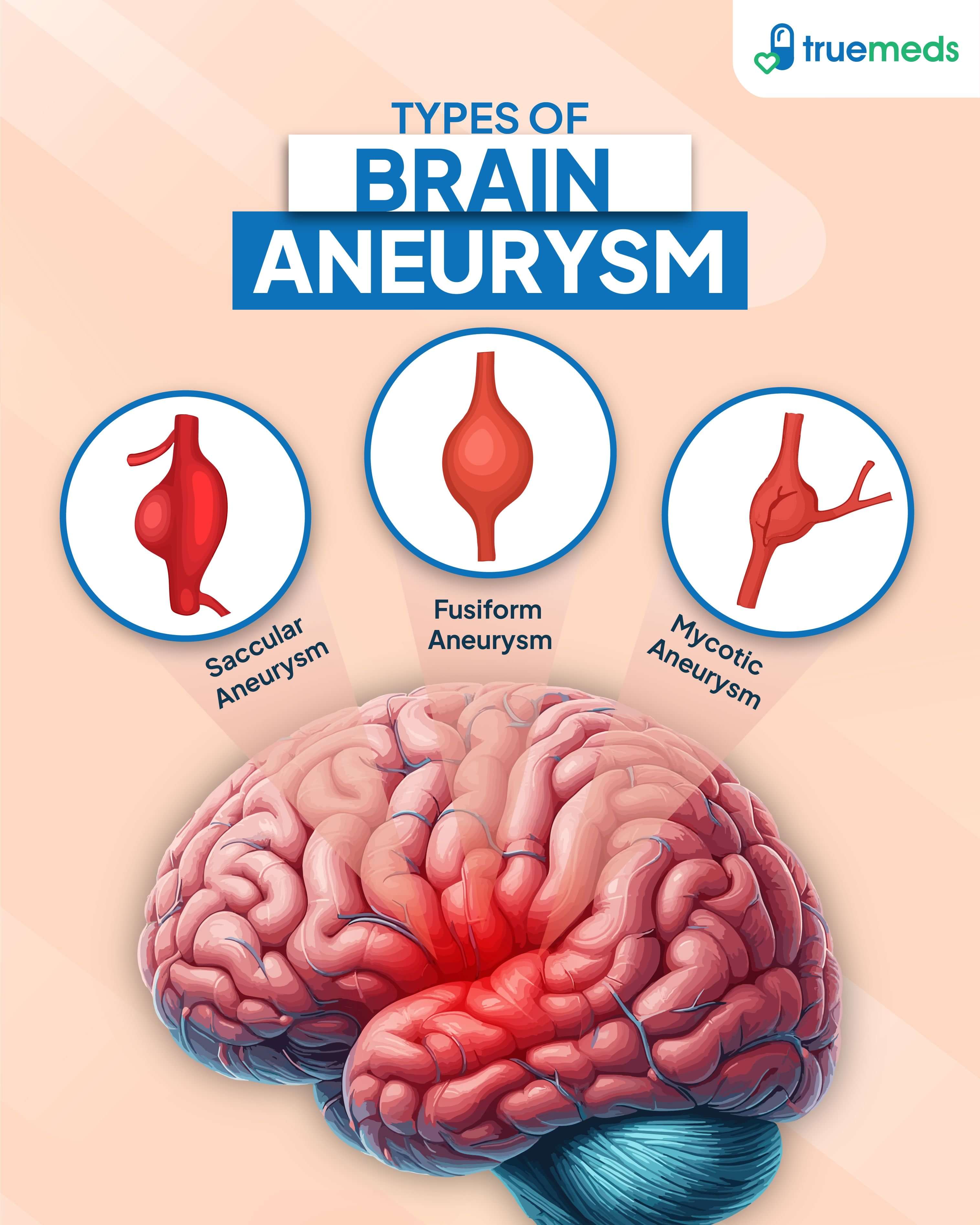
There are three main types of cerebral aneurysms, each with its characteristics and potential risks:
- Saccular Aneurysm: Also known as a berry aneurysm, this is the most common type of cerebral aneurysm. It appears as a rounded sac containing blood attached to a main artery or one of its branches. This type of aneurysm resembles a berry hanging on a stem, hence its alternative name.
- Fusiform Aneurysm: This type of aneurysm involves bulging the artery on all sides, rather than just one localised area. This type of aneurysm is less common than saccular aneurysms and can be more challenging to treat.
- Mycotic Aneurysm: A mycotic aneurysm is a rare cerebral aneurysm that develops due to an infection in the artery wall. This infection weakens the arterial wall, leading to the formation of an aneurysm. Mycotic aneurysms are often associated with bacterial endocarditis, an infection of the heart valves or inner lining.
Symptoms of Brain Aneurysm
The symptoms of a brain aneurysm can vary depending on whether the aneurysm has ruptured or not. Unruptured brain aneurysms may cause symptoms such as:
Headaches (rare, if unruptured)
Eye pain
Vision changes (e.g., loss of vision, double vision)
Diminished eye movement
Numbness or weakness on one side of the face
Difficulty speaking
Loss of balance
Difficulty concentrating or problems with short-term memory
On the other hand, symptoms of a ruptured brain aneurysm are more severe and include:
Sudden, intense headache (often referred as "the worst headache of my life")
Stiff neck
Nausea and vomiting
Drowsiness
Loss of consciousness
Photophobia
Blurred vision
Drooping eyelid
Confusion or trouble with mental awareness
Seizures
Seek immediate medical attention if you experience these symptoms, as a ruptured brain aneurysm can be life-threatening. Understanding the causes of brain aneurysms can help in identifying risk factors and taking preventive measures.
Causes of Brain Aneurysm
Brain aneurysms are caused by a weakening of the blood vessel wall in the brain, leading to a bulge or balloon-like formation. The exact cause is not fully understood, but several factors are believed to contribute to the development of cerebral aneurysms.
Ageing: The risk of developing a brain aneurysm increases with age.
Genetic Predisposition: A family history of brain aneurysms may increase an individual's risk.
Gender: Women are more likely to develop brain aneurysms than men.
Smoking: Cigarette smoking can weaken the artery walls and increase the risk of aneurysm formation.
High Blood Pressure: Uncontrolled hypertension can put additional stress on the blood vessels, making them more prone to aneurysms.
Head Injuries: Traumatic brain injuries may contribute to the development of aneurysms in some cases.
Risk Factors
Several factors can increase the likelihood of developing a brain aneurysm, also known as a cerebral aneurysm. These risk factors can be broadly categorised into genetic, lifestyle, and environmental factors.
Some of the key genetic and inherited factors include:
Family history of brain aneurysms, particularly in first-degree relatives
Polycystic kidney disease (PKD) is a genetic disorder that can weaken blood vessel walls
Connective tissue disorders like Ehlers-Danlos syndrome and Marfan syndrome
Arteriovenous malformation (AVM), which can disrupt normal blood flow in the brain
Coarctation of the aorta, a congenital narrowing of the aorta
Lifestyle and environmental factors also play a significant role in the development of cerebral brain aneurysms. These include:
Smoking, which is a major risk factor for both the formation and rupture of aneurysms
High blood pressure, as untreated hypertension can weaken blood vessel walls
Heavy alcohol consumption, especially binge drinking
Severe head trauma, although this is a rare cause of brain aneurysms
Demographic factors like age and gender can also influence the risk of developing a brain aneurysm. The risk tends to increase with age, particularly after 40. Women are more likely to develop aneurysms than men, possibly due to hormonal changes post-menopause.
Other factors that may contribute to brain aneurysm risk include atherosclerosis (plaque buildup in arteries) and body tissue disorders like fibromuscular dysplasia. Understanding these risk factors can help individuals take steps to reduce their likelihood of developing a brain aneurysm and its potential complications.
Who Do Brain Aneurysms Affect?
Brain aneurysms can affect people of all ages and genders. However, they are most commonly diagnosed in adults between the ages of 40 and 60. Women are more likely to develop brain aneurysms than men, with a ratio of approximately 3:2. Certain factors can increase an individual's risk of developing a cerebral aneurysm, including:
Family History: Having a first-degree relative (parent, sibling, or child) with a history of brain aneurysms increases the risk.
Certain Genetic Conditions: Inherited disorders such as Ehlers-Danlos syndrome, Marfan syndrome, and polycystic kidney disease can weaken blood vessels and increase the likelihood of aneurysm formation.
Lifestyle factors: Smoking and excessive alcohol consumption can contribute to the development of brain aneurysms.
Hypertension: Persistently high blood pressure can damage and weaken the arteries, making them more susceptible to aneurysms.
While these factors can elevate the risk, it is crucial to remember that brain aneurysms can occur in individuals without any known risk factors. Regular check-ups and maintaining a healthy lifestyle can help reduce the overall risk of developing this condition.
Complications
A brain aneurysm can lead to several serious complications, particularly if it ruptures. The most common and severe complication is a subarachnoid haemorrhage (SAH). This occurs when a cerebral aneurysm bursts and bleeds into the space surrounding the brain.
Symptoms of a ruptured aneurysm and SAH may include:
Sudden and severe headache
Nausea and vomiting
Stiff neck
Photophobia)
Blurred vision
Seizures
Loss of consciousness
A ruptured aneurysm is a medical emergency that requires immediate treatment to prevent potentially life-threatening complications, such as:
Rebleeding: A ruptured aneurysm can rebleed, causing further damage to the brain.
Vasospasm: Narrowing of blood vessels in the brain can occur after an SAH. This reduces blood flow and potentially leads to stroke or brain damage.
Hydrocephalus: Bleeding from a ruptured aneurysm can block the normal flow of cerebrospinal fluid. This causes a buildup of fluid in the brain (hydrocephalus).
Hyponatremia: An SAH can disrupt the balance of sodium in the body, leading to low sodium levels (hyponatremia) that can cause brain swelling.
Even if an aneurysm does not rupture, it can still cause complications by pressing on nearby brain structures or nerves. This can lead to symptoms like vision problems, numbness or weakness, and difficulty speaking. Early detection and appropriate management of brain aneurysms are crucial in preventing these potentially devastating complications.
Prevention of Brain Aneurysm
While not all brain aneurysms can be prevented, certain steps can reduce your risk of developing this cerebral condition. Some key preventive measures include:
Manage High Blood Pressure: High blood pressure is a significant risk factor for brain aneurysms. Keeping blood pressure under control through lifestyle changes and medication can help reduce the risk.
Quit Smoking: Smoking weakens blood vessels and increases the risk of aneurysm formation and rupture. Quitting smoking can significantly lower this risk.
Avoid Excessive Alcohol Consumption: Heavy alcohol consumption can raise blood pressure and increase the risk of aneurysms. Limiting alcohol intake can help mitigate this risk.
Maintain a Healthy Lifestyle: Regular physical activity and maintaining a healthy weight can support overall vascular health. Eating a balanced diet rich in fruits and vegetables also helps reduce the risk of aneurysms.
Manage Other Medical Conditions: Certain medical conditions, such as polycystic kidney disease and connective tissue disorders, can increase the risk of brain aneurysms. Proper management of these conditions is essential.
Family History Awareness: If you have a family history of brain aneurysms, it is important to discuss this with your doctor. They may recommend screening tests to detect aneurysms early.
Diagnosis & Tests
Diagnosing a brain aneurysm involves a combination of physical examination, imaging tests, and other diagnostic procedures. In many cases, aneurysms are discovered incidentally during tests for other conditions.
The following methods are commonly used to diagnose cerebral aneurysms:
CT scan (Computed Tomography): A CT scan uses X-rays to create detailed cross-sectional images of the brain. It can detect the presence of an aneurysm or bleeding in the brain.
MRI (Magnetic Resonance Imaging): An MRI uses powerful magnets and radio waves to create detailed images of the brain and its blood vessels. It can help identify the location and size of an aneurysm.
Cerebral Angiography: This is the most precise method for diagnosing brain aneurysms. It involves inserting a catheter into an artery (usually in the groin) and guiding it to the brain. A contrast dye is then injected, and X-rays are taken to visualise the blood vessels and any aneurysms.
CTA (Computed Tomography Angiography) and MRA (Magnetic Resonance Angiography): These are less invasive alternatives to cerebral angiography. They combine regular CT or MRI scans with contrast dye to create detailed images of the brain's blood vessels.
Lumbar Puncture (Spinal Tap): If a ruptured aneurysm is suspected, a lumbar puncture may be performed. It helps to check for blood in the cerebrospinal fluid, which can indicate a subarachnoid haemorrhage.
In some cases, your doctor may recommend screening for brain aneurysms if you have a family history of the condition or other risk factors. Early detection and monitoring can help prevent potentially life-threatening complications.
Treatment & Management
The management of brain aneurysms depends on whether the aneurysm is ruptured or unruptured, as well as its size, shape, location, and the patient’s overall health status. The primary goal of treatment is to prevent rupture (or re-rupture) and manage any associated complications.
1. Ruptured Brain Aneurysms
A ruptured aneurysm is a neurological emergency. Immediate treatment is essential to prevent further bleeding, reduce the risk of brain damage, and save the patient’s life.
Procedural Treatments:
- Endovascular Coiling:
A minimally invasive procedure where a catheter is threaded through a blood vessel (usually via the groin or wrist) to reach the aneurysm. Tiny coils are deployed to induce clotting inside the aneurysm, effectively sealing it off from blood flow. - Surgical Clipping:
Performed via craniotomy, a neurosurgeon places a metal clip across the neck of the aneurysm to isolate it from circulation while preserving flow through nearby vessels. This is typically done under general anaesthesia. - Flow Diversion Devices:
A stent-like device is placed across the aneurysm neck to redirect blood flow away from the aneurysm, promoting clotting and eventual healing. Examples include:- Pipeline Embolisation Device
- Surpass Streamline Flow Diverter
- FRED (Flow Re-Direction Endoluminal Device)
Medications for Ruptured Aneurysms (Supportive and Preventive):
- Nimodipine: A calcium channel blocker used to prevent cerebral vasospasm (narrowing of blood vessels), which commonly occurs after subarachnoid haemorrhage (SAH).
- Anticonvulsants (e.g., Levetiracetam, Phenytoin): May be given to prevent seizures following a rupture.
- Analgesics (e.g., Acetaminophen, Morphine): To control headache and associated pain.
- Stool Softeners (e.g., Docusate): To prevent straining, which can elevate intracranial pressure.
- Antihypertensives (e.g., Labetalol, Nicardipine): For strict blood pressure control, reducing the risk of re-bleeding.
- Vasopressors (e.g., Dopamine, Norepinephrine): If needed to maintain cerebral perfusion pressure during vasospasm.
2. Unruptured Brain Aneurysms
Management of unruptured aneurysms depends on multiple factors: aneurysm size, shape, location, growth, presence of symptoms, family history, and patient-specific factors such as age and comorbidities.
Treatment Options:
- Observation & Monitoring:
- Small, asymptomatic aneurysms (<5 mm) may be monitored through regular imaging (MRI, CTA).
- Risk factor modification: smoking cessation, blood pressure control, and cholesterol management.
- Endovascular Coiling
Often preferred for aneurysms in deep or complex locations. - Surgical Clipping
Recommended for easily accessible aneurysms or those at higher risk of rupture. - Flow Diversion Therapy
Ideal for wide-neck or fusiform aneurysms, not suitable for coiling or clipping.
Medications for Unruptured Aneurysms (Risk Reduction & Symptom Management):
- Antihypertensives (e.g., Lisinopril, Amlodipine): To maintain optimal blood pressure and reduce rupture risk.
- Statins (e.g., Atorvastatin, Rosuvastatin): It may be used to manage cholesterol levels and improve vascular health.
- Antiplatelets (e.g., Aspirin, Clopidogrel): Often prescribed before and after endovascular procedures to reduce thrombotic risk (especially with stent placement).
- Smoking cessation aids (e.g., Nicotine patches, Varenicline): Crucial for reducing rupture risk.
3. Post-Treatment Monitoring & Rehabilitation:
- Neuroimaging follow-up (MRI/MRA or CTA):
To assess treatment success and monitor for recurrence or residual aneurysm. - Rehabilitation Services:
For patients with neurological deficits post-rupture, involving physical therapy, occupational therapy, and speech-language therapy. - Lifestyle Modifications:
Stress management, healthy diet, regular exercise, and alcohol moderation help improve overall cerebrovascular health.
When to See a Doctor?
It is crucial to seek immediate medical attention if you experience any symptoms that may indicate a ruptured brain aneurysm, such as:
Sudden and severe headache
Nausea and vomiting
Stiff neck
Photophobia
Blurred vision
Seizures
Loss of consciousness
For individuals with unruptured brain aneurysms, it is essential to follow up with your doctor as recommended. They will monitor the size of the aneurysm and any changes over time to determine the available treatment options. If you experience worsening symptoms such as headaches, vision changes, or neck pain, contact your doctor promptly for evaluation.
FAQs
What exactly is a cerebral aneurysm?
A cerebral or brain aneurysm is a bulge in a weakened artery wall within the brain, which fills with blood and may rupture.
What factors contribute to the development of brain aneurysms?
Factors include inherited abnormalities in artery walls, age over 40, smoking, high blood pressure, family history, and in some cases, infections.
Is it possible to survive a cerebral aneurysm?
Yes, survival is possible, but it depends on whether the aneurysm has ruptured and how quickly medical treatment is provided.
What are the signs and symptoms of a brain aneurysm?
Unruptured aneurysms may cause headaches, eye pain, vision changes, or reduced eye movement. A ruptured aneurysm typically causes a severe, sudden headache and stiff neck.
Are there treatments available for cerebral aneurysms?
Yes, treatment options include surgical clipping (placing a clip at the aneurysm's base) and endovascular coiling (inserting coils into the aneurysm to block blood flow). Medications may also be prescribed.
What steps can be taken to prevent brain aneurysms?
Preventive measures include managing high blood pressure, avoiding smoking, maintaining a healthy diet, exercising regularly, and treating any inherited conditions that increase risk.
Who is more prone to developing a cerebral aneurysm?
Individuals over 40, those with a family history of aneurysms, smokers, and people with uncontrolled high blood pressure are at higher risk.
Can a brain aneurysm occur in an otherwise healthy individual?
Yes, even seemingly healthy individuals can develop brain aneurysms, as some risk factors, such as inherited abnormalities in artery walls, may go undetected.
References
American Association of Neurological Surgeons. (2021). Cerebral aneurysm. https://www.aans.org/en/Patients/Neurosurgical-Conditions-and-Treatments/Cerebral-Aneurysm
Johns Hopkins Medicine. (n.d.). Aneurysm. https://www.hopkinsmedicine.org/health/conditions-and-diseases/aneurysm
Medline Plus. (2021). Cerebral aneurysm. https://medlineplus.gov/ency/article/000781.htm
National Institute of Neurological Disorders and Stroke. (2021). Cerebral aneurysms fact sheet. https://www.ninds.nih.gov/Disorders/Patient-Caregiver-Education/Fact-Sheets/Cerebral-Aneurysms-Fact-Sheet
Brisman, J. L., Song, J. K., & Newell, D. W. (2006). Cerebral aneurysms. New England Journal of Medicine, 355(9), 928-939. https://doi.org/10.1056/NEJMra052760
Etminan, N., & Rinkel, G. J. (2016). Unruptured intracranial aneurysms: Development, rupture and preventive management. Nature Reviews Neurology, 12(12), 699-713. https://doi.org/10.1038/nrneurol.2016.150
Latest health articles
Top Health Essentials














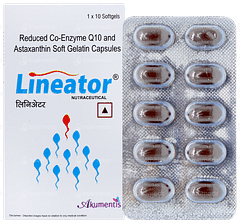


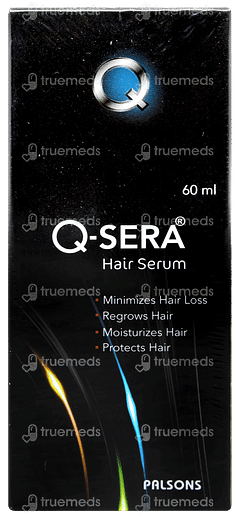


Disclaimer
Top-Selling Medicines:
...View more
Top-OTC medicines:
...View more
Company
About UsHealth ArticleHealth StoriesHealth LibraryDiseases & Health ConditionsAyurvedaUnderstanding Generic MedicinesAll MedicinesAll BrandsNeed HelpFAQSecuritySubscribe
Registered Office Address
Grievance Officer
Download Truemeds
Contact Us
Our customer representative team is available 7 days a week from 9 am - 9 pm.
v4.10.1
2025 - Truemeds | All rights reserved. Our content is for informational purposes only. See additional information.
Our Payment Partners









